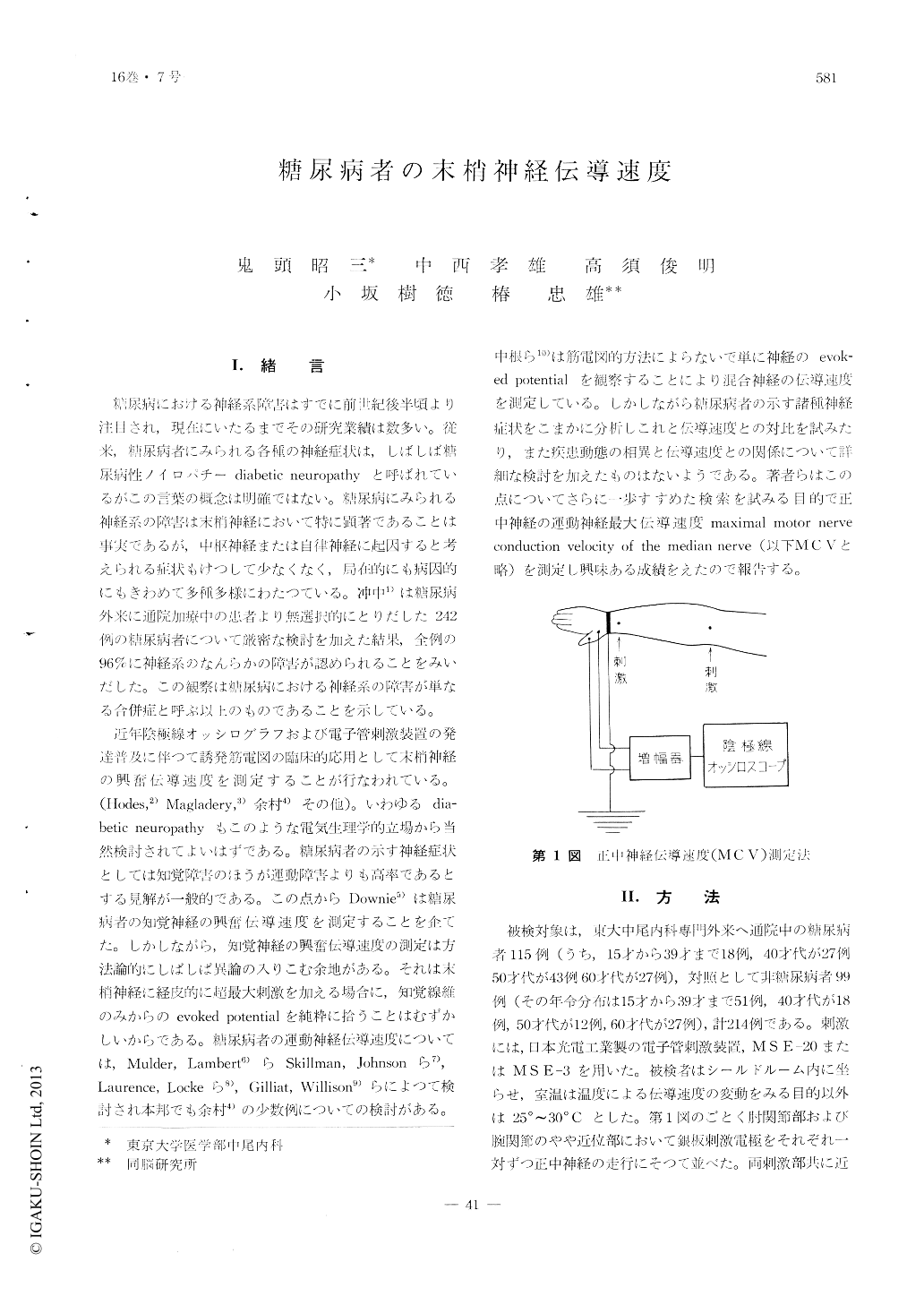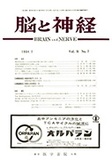Japanese
English
- 有料閲覧
- Abstract 文献概要
- 1ページ目 Look Inside
I.緒言
糖尿病における神経系障害はすでに前世紀後半頃より注目され,現在にいたるまでその研究業績は数多い。従来,糖尿病者にみられる各種の神経症状は,しばしば糖尿病性ノイロパチーdiabetic neuropathyと呼ばれているがこの言葉の概念は明確ではない。糖尿病にみられる神経系の障害は末梢神経において特に顕著であることは事実であるが,中枢神経または自律神経に起因すると考えられる症状もけつして少なくなく,局在的にも病因的にもきわめて多種多様にわたつている。冲中1)は糖尿病外来に通院加療中の患者より無選択的にとりだした242例の糖尿病者について厳密な検討を加えた結果,全例の96%に神経系のなんらかの障害が認められることをみいだした。この観察は糖尿病における神経系の障害が単なる合併症と呼ぶ以上のものであることを示している。
近年陰極線オッシログラフおよび電子管刺激装置の発達普及に伴つて誘発筋電図の臨床的応用として末梢神経の興奮伝導速度を測定することが行なわれている。(Hocies,2) Magladery,3) 余村4)その他)。いわゆるdia—betic neuropathyもこのような電気生理学的立場から当然検討されてよいはずである。糖尿病者の示す神経症状としては知覚障害のほうが運動障害よりも高率であるとする見解が一般的である。この点からDownie5)は糖尿病者の知覚神経の興奮伝導速度を測定することを企てた。しかしながら,知覚神経の興奮伝導速度の測定は方法論的にしばしば異論の入りこむ余地がある。それは末梢神経に経皮的に超最大刺激を加える場合に,知覚線維のみからのevoked potentialを純粋に拾うことはむずかしいからである。糖尿病者の運動神経伝導速度については,Mulder, Lambert6)らSkillman, Johnsonら7),Laurence, Lockeら8),Gilliat, Willison9)らによつて検討され本邦でも余村4)の少数例についての検討がある。中根ら10)は筋電図的方法によらないで単に神経のevok—ed potentialを観察することにより混合神経の伝導速度を測定している。しかしながら糖尿病者の示す諸種神経症状をこまかに分析しこれと伝導速度との対比を試みたり,また疾患動態の相異と伝導速度との関係について詳細な検討を加えたものはないようである。著者らはこの点についてさらに一歩すすめた検索を試みる目的で正中神経の運動神経最大伝導速度maximal motor nerve conduction velocity of the median nerve (以下MCVと略)を測定し興味ある成績をえたので報告する。
Motor nerve conduction velocity of the median nerve of the diabetics was smaller than that of the non-diabetics. The degree of reduction had relation to duration of the disease, the fasting blood sugar level at the first examination and state of blood sugar control, but had little relation to degree of arteriosclerosis of the ocular fundus. As to the relation to the fasting blood sugar level at the first examination, the reduction in the conduction velocraty was marked when the level was higher than 300 mg/dl, and it was consistent with the observations from the clinical neurological viewpoint. As for the relation to state of blood sugar control, the conduc-tion velocity was definitely lower in the "Fair" group than in the "Good" group, but no definite difference was observed between "Fair" and "Poor". In relation to neurologic symptoms, reduction in the median motor nerve conduction veiocity (abbre-viated to MCV) was related to absence of the deep reflexes, disturbance of pallesthesia, and autonomic disturbances (impotence), but had no relation to superficial sensory disturbances. Generally, MCV was assumed to have a stronger relation to the deep reflexes than sensory disturbances. Furthermore, clinical characteristics of fourteen patients whose MCV reduced remarkably were surveyed, three cases of juvenile diabetes mellitus were comparatively studied, and the courses of several patients were followed. The results of these observations revealed that reduction in MCV was marked in those whose blood sugar levels were high and states of blood sugar control were poor. Also it was definite that absence of deep reflexes and disturbance of palles-thesia were noted in almost all the cases. There was, however, a case of which blood sugar level was high, and control was difficult, besides such conditions as absence of deep reflexes and distur-bance of pallesthesia were complete, and yet the peripheral motor nerve conduction velocity remained normail. In repeated measurement of MCV in the course of treatment of patients whose peripheral nerve conduction velocities had been reduced, the clinical neurologic symptoms improved in accompany with improvement of blood sugar control and the nerve conduction velocities were normalized in paral-lel with them. However, which normalization ap-peared earlier, conduction velocity of clinical signs, differed with cases and there seemed no uniformity on this point.

Copyright © 1964, Igaku-Shoin Ltd. All rights reserved.


